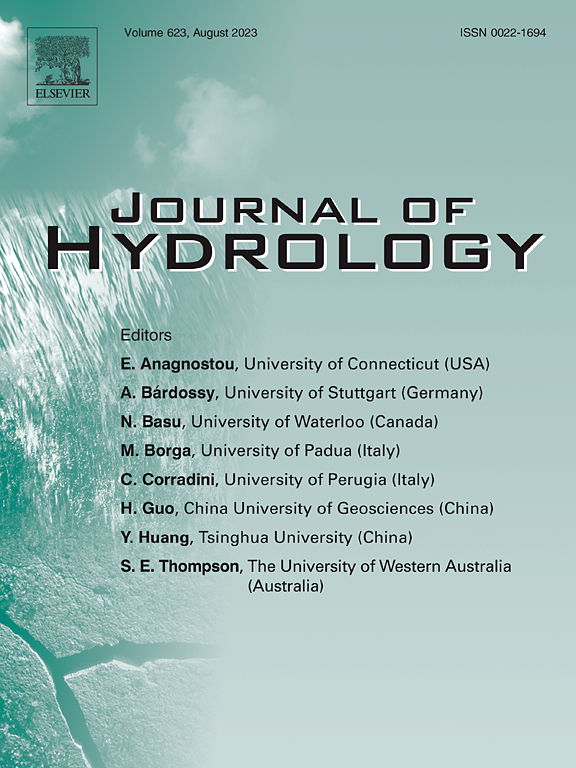羟基化二氧化硅表面对分子尺度水冻结的影响及其对非饱和冻土的影响
IF 6.3
1区 地球科学
Q1 ENGINEERING, CIVIL
引用次数: 0
摘要
在非饱和冻土这一多相复杂体系中,初始含水量对未冻水含量的影响尚不清楚。了解这种影响对于确定土壤冻结特征曲线(SFCC)是至关重要的,SFCC是冻土宏观尺度数值模型中的本构关系。这个尚未解决的问题源于缺乏对潜在机制的理解,包括微尺度过程和界面效应。在这里,我们采用分子动力学(MD)模拟研究了基于羟基化二氧化硅表面的水冻融过程,类似于未冻结的土壤系统。结果表明,水和二氧化硅之间的界面通过氢键形成有序结构,表明水分子被二氧化硅表面吸引。二氧化硅表面的存在使水三相点降低5.0 K。随着含水量的增加,随着孔隙尺寸的增大,孔隙尺寸每增加10 nm,三相点进一步减小近10.0 K。通过一个简单但基于物理的模型,我们发现水到硅烷醇基团的距离越小,对应于初始含水量越低的体系,导致电位井越深,随后需要更多的相变能量和更高的三相点。更深的电位井也限制了水分子的运动,导致较小孔隙内的动态过程较慢。这意味着初始含水量对于获得SFCC很重要,因为初始含水量会影响水三相点。本文章由计算机程序翻译,如有差异,请以英文原文为准。
Effects of hydroxylated silica surface on molecular-scale water freezing with implications for unsaturated permafrost
In unsaturated frozen soil, a multi-phase complex system, the influence of initial water content on the unfrozen water content remains unclear. Understanding this influence is essential for determination of the soil freezing characteristic curve (SFCC), a constitutive relation in macroscale numerical models for permafrost. This unresolved issue stems from a lack of understanding of the underlying mechanisms, including microscale processes and interfacial effects. Here, we employed molecular dynamics (MD) simulations to investigate the water freezing-thawing process based on hydroxylated silica surface, resembling an unfrozen soil system. The results revealed that the interface between water and silica forms an ordered structure via hydrogen bonding, indicating an attraction of water molecules to the silica surface. The presence of the silica surface depresses the water triple point by 5.0 K. As the water content increases, along with the pore size, the triple point decreases further by nearly 10.0 K for a 10 nm increase in pore size. Through a simple yet physically based model, we identified that a smaller distance from water to silanol groups, corresponding to systems with lower initial water content, leads to a deeper potential well, which subsequently requires more energy for phase change and higher triple point. The deeper potential well also restricts the movement of water molecules, resulting in slower dynamic processes within smaller pores. This implies that the initial water content is important in obtaining the SFCC, since the initial water content can affect the water triple point.
求助全文
通过发布文献求助,成功后即可免费获取论文全文。
去求助
来源期刊

Journal of Hydrology
地学-地球科学综合
CiteScore
11.00
自引率
12.50%
发文量
1309
审稿时长
7.5 months
期刊介绍:
The Journal of Hydrology publishes original research papers and comprehensive reviews in all the subfields of the hydrological sciences including water based management and policy issues that impact on economics and society. These comprise, but are not limited to the physical, chemical, biogeochemical, stochastic and systems aspects of surface and groundwater hydrology, hydrometeorology and hydrogeology. Relevant topics incorporating the insights and methodologies of disciplines such as climatology, water resource systems, hydraulics, agrohydrology, geomorphology, soil science, instrumentation and remote sensing, civil and environmental engineering are included. Social science perspectives on hydrological problems such as resource and ecological economics, environmental sociology, psychology and behavioural science, management and policy analysis are also invited. Multi-and interdisciplinary analyses of hydrological problems are within scope. The science published in the Journal of Hydrology is relevant to catchment scales rather than exclusively to a local scale or site.
 求助内容:
求助内容: 应助结果提醒方式:
应助结果提醒方式:


